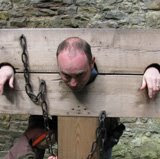Well, more than I realised perhaps. It's felt both hectic and sometimes unproductive lately but I have moved forwards on quite a few things, though a couple of thorns remain firmly embedded in my side. This has been a week of payoffs for the previous few, as things come to fruition. In no particular order, in fact in random chaos because I'm in a rush, here's some stuff I've been busy with.
The discussion I kicked off on the MCG list about APIs and the EDL was really stimulating, though I never managed to find the time to respond to several of the interesting responses I had. There was interesting feedback on the idea of the EDL itself, or any effort at centralising content. There were also plenty of thoughts about what make good characteristics of APIs and what their uses may be, plus suggestions of examples. I now need to use these in preparing a talk for the EDL WP3 meeting in Paris on the 3-4 March. I've been working on this quite hard, well, sort of, in between the rest, and my own ideas about APIs and indeed the Semantic Web have been evolving a little. Preparation of my survey questionnaire is another area of (out of hours) activity.
What else? I spent 3 days on preparing an out of print guide to pottery fabrics for the web. I started with a PDF of the 200 page Quark document from 10 years ago, exported XML, did some cleaning by hand, passed it through three sets of transformations to structure data and then on to TEILite, and adapted another transformation to display this as HTML. It's not perfect yet and we need to hook all the images in to it, as well as proof read etc., but it was a good proof of how one can take this content and semi-automate the creation of a nicely structured version. The plan had been to database it, and I was just going to get structured data on each fabric out but we seemed to close to what I ended up doing that I went ahead. It felt good.
I did more preparation for moving the events database out of Oracle and into SQL Server; refined some ideas with the help of the microformats list (in short, sod that, it's going to be eRDF for me or something like); met Mike Ellis to talk about the ways that Eduserve can work with museums, gab about microformats and all the rest; talked with a consultant we have working on the Port of London Archives, held at Museum in Docklands, about IT requirements, OAI-PMH and so on (followed up today with a grand assembly of all his interviewees, very interesting); worked on the London's Burning site for key stage 1 kids (more fancy pants XSLT for me, but the good bit will be a great interactive by ON 101); also work on integrating a new game, Family Favourites, soon to be launched at MiD; I got RSS feeds (and other XML sources) drawn into our site server-side (not in a public place yet, but working) and along the way rediscovered a baby REST interface I'd built in the autumn. At present this just lets you search the MoLAS publications, but events and collections are but a short way off if I get a few minutes. I advised on the procurement of a new map application for the London Sugar and Slavery gallery, although we only just made one. Still, there's money to pour away and it must be poured before the end of the financial year. Damn that financial year, it's the bane of my life right now! And I've been trying to get this blasted generic timeline project back on track. Happily today I had a meeting where we got ourselves a plan of action, and just a moment ago spoke to the designer about the next steps so now I hope there's time to get it done before, you guessed it, the end of the financial year...
Quick note: Waibel and Godby reporting on the MCN 2007 (just published in Ariadne) made some interesting observations, including: "During the public CDWA Lite Advisory Committee meeting, Inge Stein (Konrad-Zuse Zentrum für Informationstechnik, Berlin) presented on Museumdat [4], a harmonisation of CDWA (Categories for the Description of Works of Art) Lite with the CIDOC (Committee on Documentation of the International Council of Museums) Conceptual Reference Model). One of the motivations for this effort: with a small amount of changes, CDWA Lite could be used for all objects across the cultural heritage spectrum, whereas currently it is optimised exclusively for fine art. All delegates agreed that the changes proposed by the German museum community should form the basis for the next version of CDWA Lite. Monika Hagedorn-Saupe (Institute for Museums Studies, Germany), Inge Stein and the Advisory Committee agreed that a single international version of the standard would be desirable."
"The Town Hall Meeting on Intellectual Property: Museum Image Licensing – The Next Generation provoked a lively debate, with many points of view represented by both presenters and delegates, and little evidence of an emerging consensus around the business model for sustaining digital image provision: the room seemed divided between those who feel that the museum community can make the most impact in our information economy by providing open access whenever legally possible, and those who favour business models of cost recovery or even revenue generation. "
